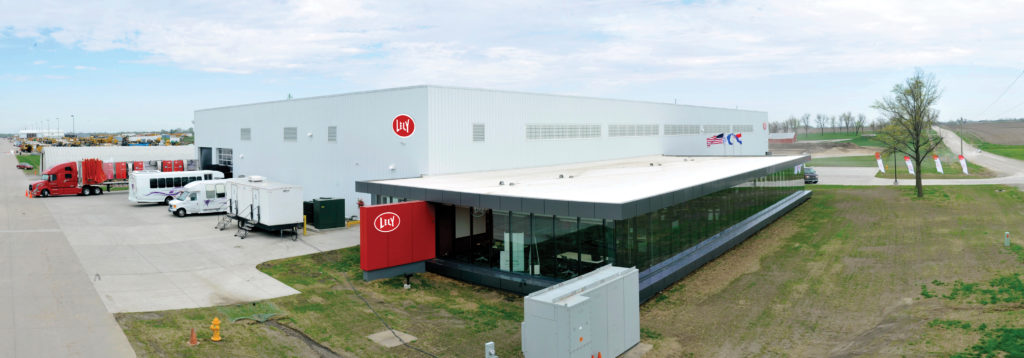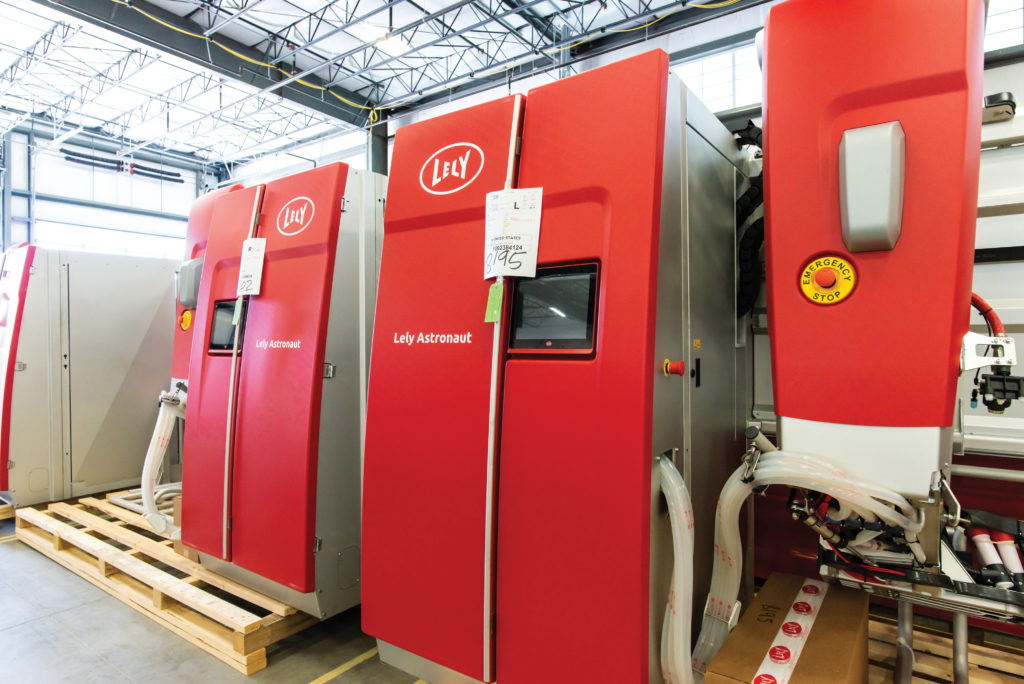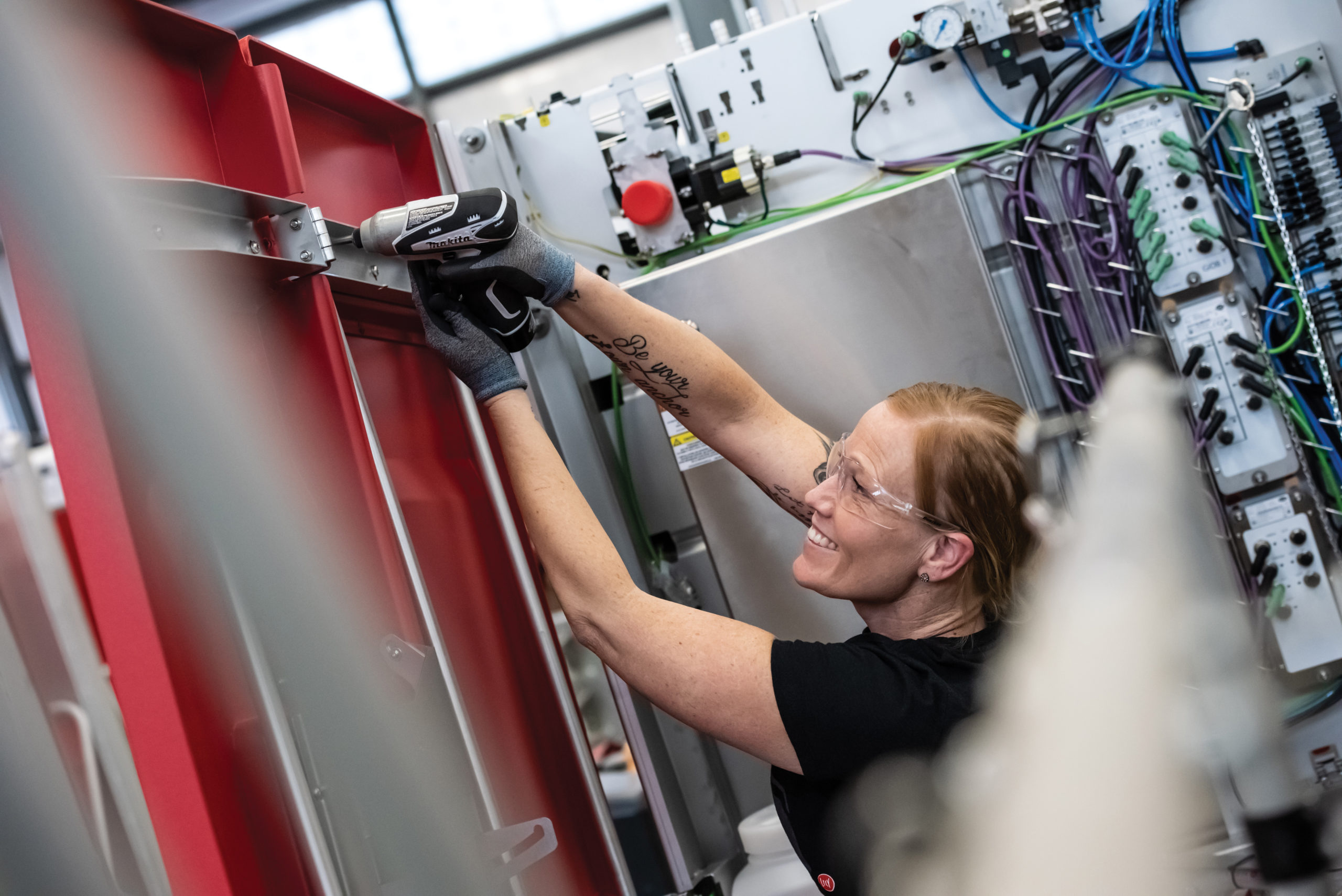Company’s ‘Farm of the Future’ model helps drive innovation
If you were to put three or four generations of Americans in a room and ask for a show of hands for whoever milked cows as a farm kid, the oldest hands would surely dominate that contest. As people migrate farther and farther from rural areas and farm backgrounds, there will also be a diminishing number of people with agricultural backgrounds who plan to work on farms.
Pair that fact with rising labor costs and the reality of feeding billions of additional people globally in the coming decades, and you have a formula for success for a company that has specialized for decades in automating dairy operations.
For the past 16 years, Lely North America has enjoyed better-than-anticipated growth in sales of the bright-red robotic milking machines that it produces at its Pella plant. This summer, the company’s further expansion in North America is taking shape as work progresses on a new headquarters complex just south of Iowa Highway 163.
With an expected opening in the first quarter of 2022, the 100,000-square-foot facility will give the Netherlands-based company deeper roots in Iowa and could pave the way for a larger role for its emerging North American operations.
Lely Group, a Dutch company founded in 1948, develops robotics and data analytics that improve animal welfare, flexibility and production on dairy farms. The innovative company has generated more than 1,600 patent filings over its seven-decade history, beginning with one of its earliest inventions, the finger wheel rake. With its Iowa expansion, products currently manufactured in Europe by Lely will soon be manufactured in Pella. Lely North America brought production for the United States and Canadian markets to Pella in 2004.
Lely currently employs about 55 people at its Pella plant. The new facility, which will more than double the square footage of the current North American headquarters, will enable the company to add 15 additional employees. The bulk of Lely’s 1,300-member workforce is based in Europe.
InnovationIOWA magazine interviewed Chad Huyser, president of Lely North America, to learn more about the company, its mission and philosophy on innovation, and its plans for Iowa and the North American market.
Having attended a groundbreaking ceremony at the building site last fall, I had heard the company’s mission statement:
“Lely’s mission is to inspire people to create innovative solutions that help our customers excel in sustainable milk production, forage harvesting and energy sourcing. Our mission sets our direction for the future. We create and drive breakthrough changes in farming methods. It’s our true north.”

How did innovation become such an important part of Lely’s identity?
If we go back 70 or so years with our founding as an organization, it was really founded on what you might call a simple innovation. From our very beginning in 1948, we were looking for better or new ways to solve the challenges of today and tomorrow’s world. Our focus has remained primarily in agriculture, and certainly in the last 25 to 30 years primarily around automation and robotics as it relates to innovation.
Our core purpose of why we exist as an organization is somewhat captured in our vision statement, which talks about creating a sustainable, profitable and enjoyable future in farming. That’s why we get up every morning — how we deliver that. As an organization, through our teams of people, we really try to put as few boundaries out there in terms of developing new solutions to problems that may exist today. Or better yet, we try to anticipate or find a solution for a need that maybe the market doesn’t know it has today.
I use the robotic milking system, which was one of our early automation innovations, as an example. In the time when this was being first designed and the first prototypes were being developed, the market wasn’t asking for this type of solution. I don’t think the market actually even dreamed that something would be able to do that in the way that we now do. And fast-forwarding 25 years later, that’s the type of environment that we try and create for our design teams, for our employees at large, whatever their role might be. …
How is the research and development organized between the European and North American operations?
When we look at R&D, we really have two facets in our organization. We have a group of people based in the European headquarters area that we call our innovations factory. Their sole purpose is, for lack of a better term, to be the dreamers of our organization. They have no boundaries given to them. They are in an extremely unique and creative group of people who are really trying to look for revolutionary breakthrough types of innovations.
The process they use then translates into the second part of our R&D world. Through a thorough process of validation they bring forward an idea or two conceptually, then eventually it’s handed off to what I call more of the traditional R&D teams to bring it forward as a commercially viable product. … That’s really where you start to see collaboration with the North American market, through our product management teams. We don’t have any formal R&D engineers based here in North America yet, but as we’ve grown in significance within the Lely global organization, those are conversations that are underway.
What would you say the broad themes are in ag tech as far as new demands for technological solutions?
One of the things that drives a lot of our innovation and, frankly, drives our owner and founder, is a simple yet almost overwhelming initiative — that agriculture’s primary responsibility is to feed a growing population around the world. We know that population is going to grow in the next 20, 30, 40 years to potentially billions more people that are going to need to sustain themselves. So in one sense, our mission in agriculture hasn’t changed for the last 500 years.
When we begin to translate that down from the 250,000-foot view, we look at how we are going to do that in a sustainable way with limited resources. This is where automation and technology comes in. As we know in agriculture, we’re going to have to do all these big-idea things with fewer people available who want to work in agriculture. … The reality, we believe, is that automation hardware is just beginning to truly unlock what we call the next big revolution we see coming in agriculture.
That’s taking all of the information that we’re now able to gather through this innovative hardware in the form of data and start to correlate all this information together to make better decisions about how we produce — whether that’s a stalk of corn, a stalk of soybeans, an acre of alfalfa, an acre of wheat, or how produce a fluid milk product from a dairy animal. … I think that’s where you’re going to see the next rounds of tremendous innovation, is in the data science side of all the data we’re now gathering in agriculture.

What’s on the horizon as the next core products for Lely?
We’ve continued to follow what we call our “Farm of the Future” vision, which is really, we believe we can look at task-based manual work — in this case, we’ll say a dairy farm, and we can automate that. So whether that’s around the milking process, the feeding process, how we manage renewable resource manure management, or in some cases, how we actually take the value product that is the fluid milk coming off the farm, and can we add more value to that before it actually leaves the farm?
I think our view is, if we can automate those things, we solve several of the points that I mentioned just a moment ago. We solve the fact that labor is no longer available in the quantity – or in some cases more important in the quality – [and] continue to operate agriculture in the ways that we always have [operated] dairy farms. There’s not enough people that want to milk cows, and to do it the same way we’ve done it for the last 30 or 40 years. The same thing can be said for feeding. That’s only just purely looking at the labor component. Then if you get into the other value-added effects … we believe there will be multiple kinds of core products that are really driven around that vision of what we call the Farm of the Future. That’s happening outside of the dairy barn also with companies like John Deere and DuPont Pioneer [now Corteva].
What is the market potential for more robotics in the dairy industry?
If you look in the North American market, today there’s about 9.2 million dairy cows in the United States, and there’s just under 1 million in Canada. But we know today that in the U.S., less than 3½% of the dairy cows are milked with automated equipment, and even fewer of them are fed with automated or robotic solutions. So we’ve barely scratched the surface of further moving the adoption needle of automation into dairy farms. If we look comparatively to Canada, they’re a little farther ahead — about 11 to 12% of cows are milked using automated solutions. Any way you look at it, there are hundreds of thousands, if not millions, of cows whose farmers are still using conventional technology.
At the groundbreaking ceremony last fall there were some mentions of a model farm near the Netherlands headquarters. Is something like that envisioned near the Pella headquarters?
We have [in the Netherlands] what we call a Lely Farm Model or Farm of the Future where to some degree we beta test and pilot concepts to make sure that there is a viability. It’s in the later stages of product proving or that product validation stage. So in some respects, we absolutely do try – as we would say – to put our money where our mouth is.
As part of our new product introduction processes, we do go through two phases of validation and verification where we will validate new products all over the world, including here in North America. So I can tell you there are new concepts that were tested today that only a handful of people know about that are working on farms here in the U.S. market today, to get real-world validation feedback that continues to refine that product improvement process to move towards commercial viability. We have validation farms in the East, in Quebec and in the western U.S.
As we potentially develop stronger partnerships [in Iowa] with agtech and accelerator-type companies and incubators, where we might find collaborative efforts where maybe there’s a validation step that they’re working on where we can integrate it, or we see an opportunity integrated with our products, there could be some micro-versions of those things that could happen in the local area.
We know we want to be sustainable. We know our dairy farmers, our ag producers need to have an enjoyable and yet a financially viable future going forward; otherwise, they won’t remain in the business. So we feel like we have a role we can play there. We’ve been more or less following that road map for 70 years, and I’d say there’s nothing that says we won’t continue to follow that for the next 70 as we go forward. That’s really the heart of the DNA of who we are as an organization.
